For almost 50 years, Barry Johnson has been sharing the wisdom of polarities and his set of polarity thinking principles.
I love learning things that are such no-brainers that they make me wonder, “How did I make it this far in life without knowing this?” Polarity thinking is one of those things.
If you want to dive deeper into polarities, check out the books Polarity Management: Identifying and Managing Unsolvable Problems (Amazon) along with And: Making a Difference by Leveraging Polarity, Paradox or Dilemma (Amazon).
If you’re looking for a video intro to Barry Johnson, I highly recommend starting here:
Quick Housekeeping:
- All visuals and quotes are from Barry Johnson and/or Polarity Partnerships. I’ve only included information from publicly available sources.
- I’ve added emphasis to quotes in bold.
- I’ve organized the content into my own themes and flow.
Post Contents: Click a link here to jump to a section below

Polarity Thinking 101: An Introduction to the Power of Polarities (+ Visuals)
What is a Polarity?
Also known as: paradoxes, dilemmas, chronic tensions, positive opposites, interdependent pairs, wicked problems, dual strategies, yin and yang, etc.
Polarities are:
- “A gift of nature, a natural phenomenon like gravity and sunshine.”
- “An underlying phenomenon that works in predictable ways.”
- “Patterns that exist within complexity that can help us get a handle on it.”
- “Energy systems that we can leverage—so we can be intentional about using the energy that they provide.”
- “Interdependent pairs that need each other over time.”
- “Unavoidable, unsolvable (in that you can’t choose one pole as a sustainable solution), indestructible, and unstoppable.”
- “Exist in every level of system from the inside of our brains to global issues.”
The basics of a polarity, visualized:
- “Our most basic picture of the interdependent pair includes two poles and an energy system that flows between and around them in the form of an infinity loop.”
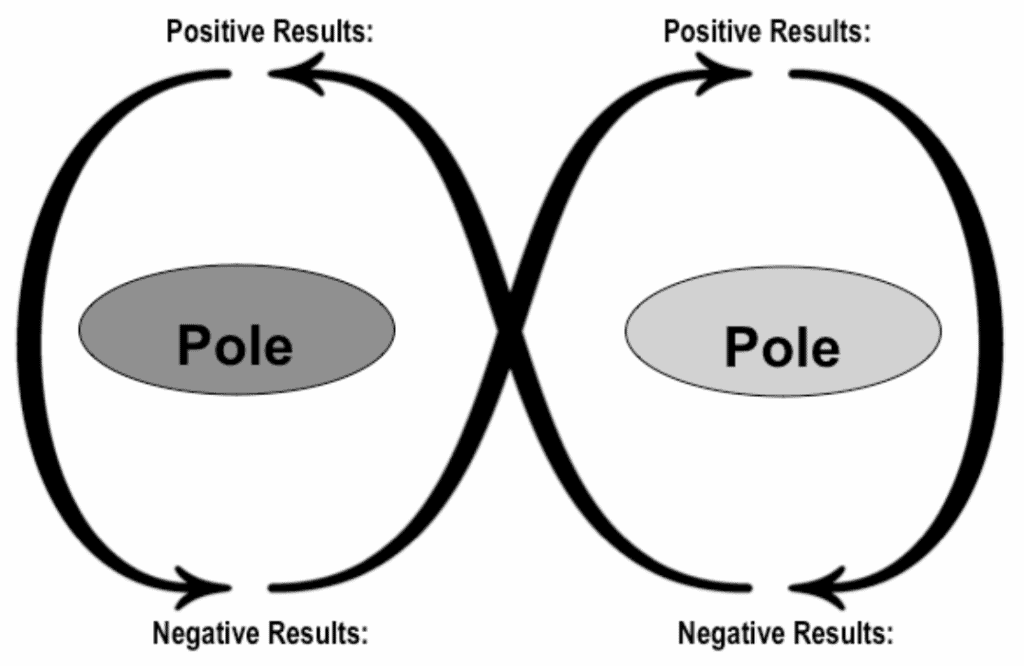
How a polarity works:
- “When the energy crosses between the two poles, it is experienced in the system as ‘tension.’ With this tension, we often assume that we must choose one of the poles as a ‘solution’ to the tension. This is a false choice because the poles are inseparable. The tension is unsolvable in that one cannot choose either pole as a sustainable ‘solution.’ This interdependent pair is also unavoidable.“
- “There is a natural flow from the downside of one pole to the upside of the other. After moving into the upside of the opposite pole the system, over time, will reach its limits and move toward the downside of that pole. This creates natural pressure to self correct by moving to the upside of the original pole. This flow looks like an infinity loop which is a helpful symbol because polarities are ongoing. To ‘solve’ them is to learn how to manage them well over time.”
- “As the energy crosses between the two poles, it separates them. This reflects the reality that the two poles never collapse into one. They are always differentiated. As the energy wraps around each of the poles, it holds them together as an interdependent pair. This reflects the reality that the two poles come as a set and need each other over time. They are always connected.”
It’s critical to remember:
- “With polarities, over time, there is no such thing as win/lose, there is only win/win or lose.”
- “Each pole brings something positive to the pair and each pole becomes a liability without its interdependent pole partner.”
- “The more we understand about the elements of this phenomenon and the dynamics by which it functions, the more effective we can be at leveraging its energy. This leveraging can support us in pursuing our most expansive dreams and addressing our most chronic issues—as individuals, families, organizations, nations, and humanity.”
Polarity Examples
Inhale and Exhale Polarity:
“Interdependent pairs are a ubiquitous reality that has been with us since the beginning of time. We are born into them with our first breath—Inhaling AND Exhaling is an interdependent pair.“
- “You do not solve the exhale/inhale polarity by choosing to either inhale or exhale. You manage it by getting the benefits of each while appreciating the limits of each. It is not a static situation. It is a process, an ongoing flow of shifting emphasis from one to the other and back again.”
- “There are two forces contributing to the shift from one pole to the other: the increased pressure from the downside of one pole and the increased attractiveness of the upside of the opposite pole. For example, inhale and hold your breath. The longer you hold your breath, the greater the pressure from the downside of inhaling and the more attractive exhaling becomes.”
Here’s what it looks like when each pole is leveraged appropriately to maximize the upsides while minimizing the downsides. Also, notice that the word “and” is inserted between the poles:
- “With all polarities—because they are interdependent—it makes no sense to connect them with ‘or.’ We need to connect them with ‘and.’“
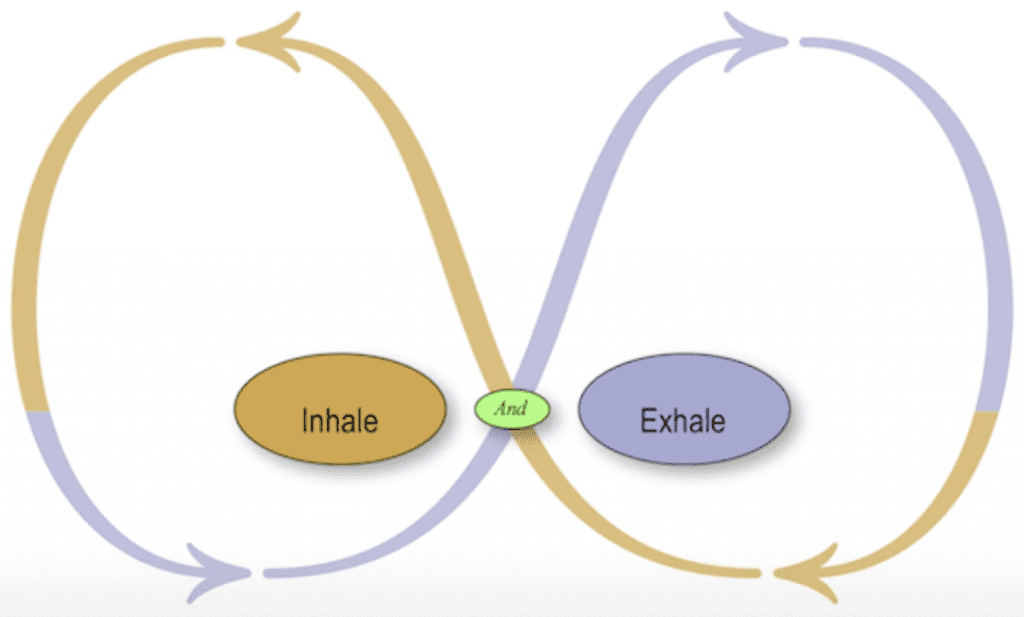
Activity and Rest Polarity:
Let’s take a deeper look at another real-life polarity we experience daily: activity and rest.
We’ll start with the same format, but we’ll build on it from here. You’ll notice that the upsides are marked with “values,” and the downsides are “fears”:
- “All polarities have 2 sets of values and fears that are in tension.”
- “What we try to do with all polarities is we want to maximize both upsides … and we want to minimize the downsides.”
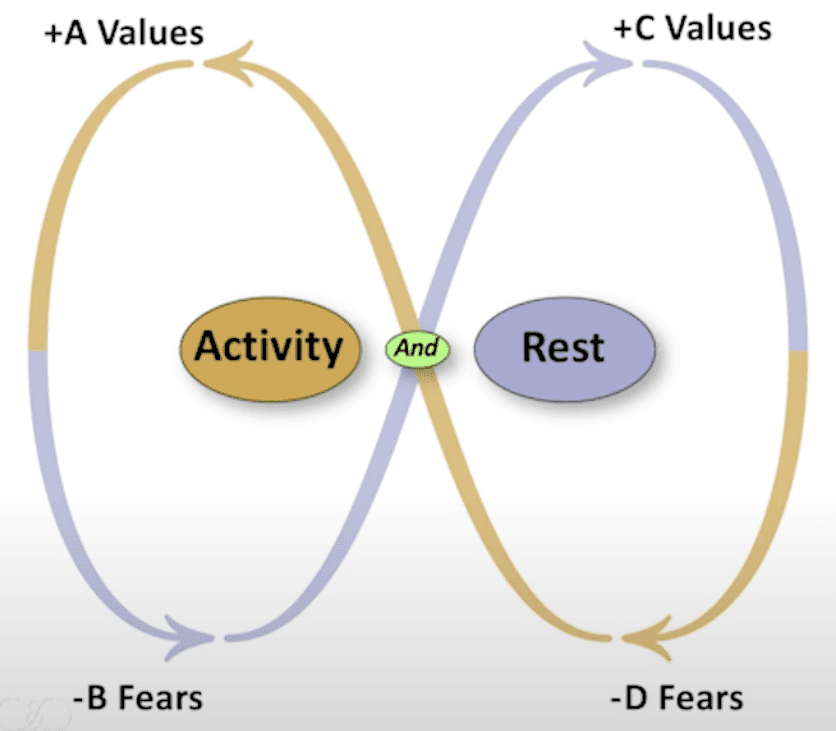
You can fill in the blanks for the values and fears of each pole:
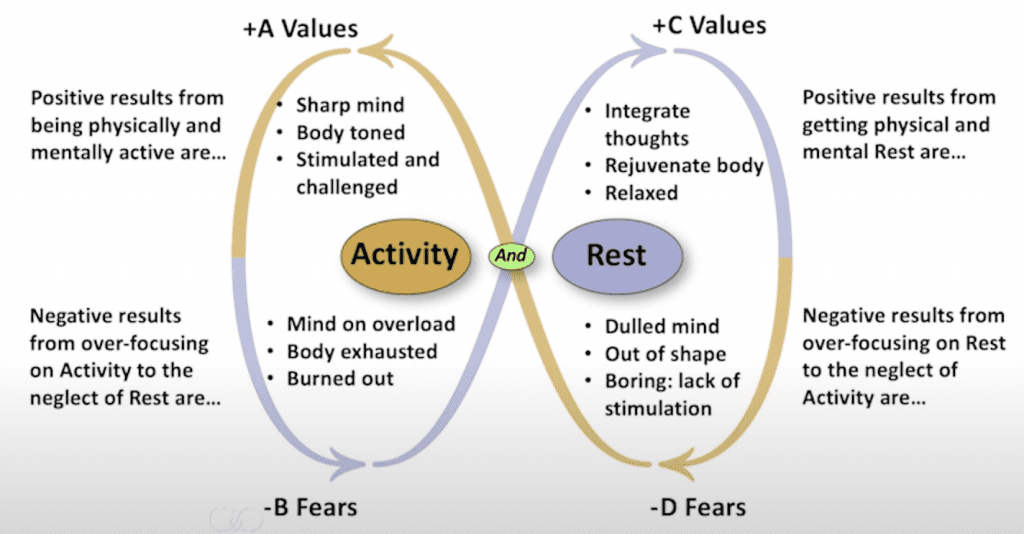
The Polarity Map:
Now that you’ve got the gist of polarity basics, let’s introduce The Polarity Map (note: this is from Polarity Partnerships).
Here’s what a blank Polarity Map template looks like:
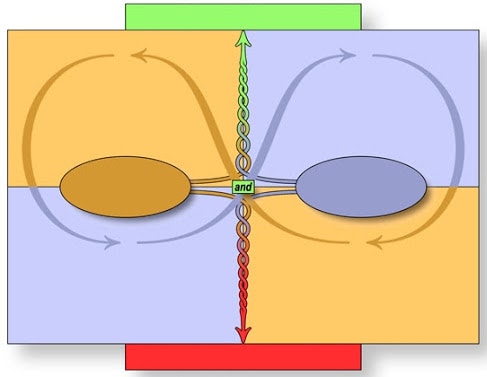
Something you’re probably noticing that’s been added are the vertical, intertwined, energy arrows pointing to “greater purpose” and “deeper fear”:
- “There’s a natural tension between the poles of a polarity, but it can be leveraged in such a way that it creates a virtuous cycle of energy lifting you towards a greater purpose.” (or vicious cycle of energy pushing towards a greater fear)
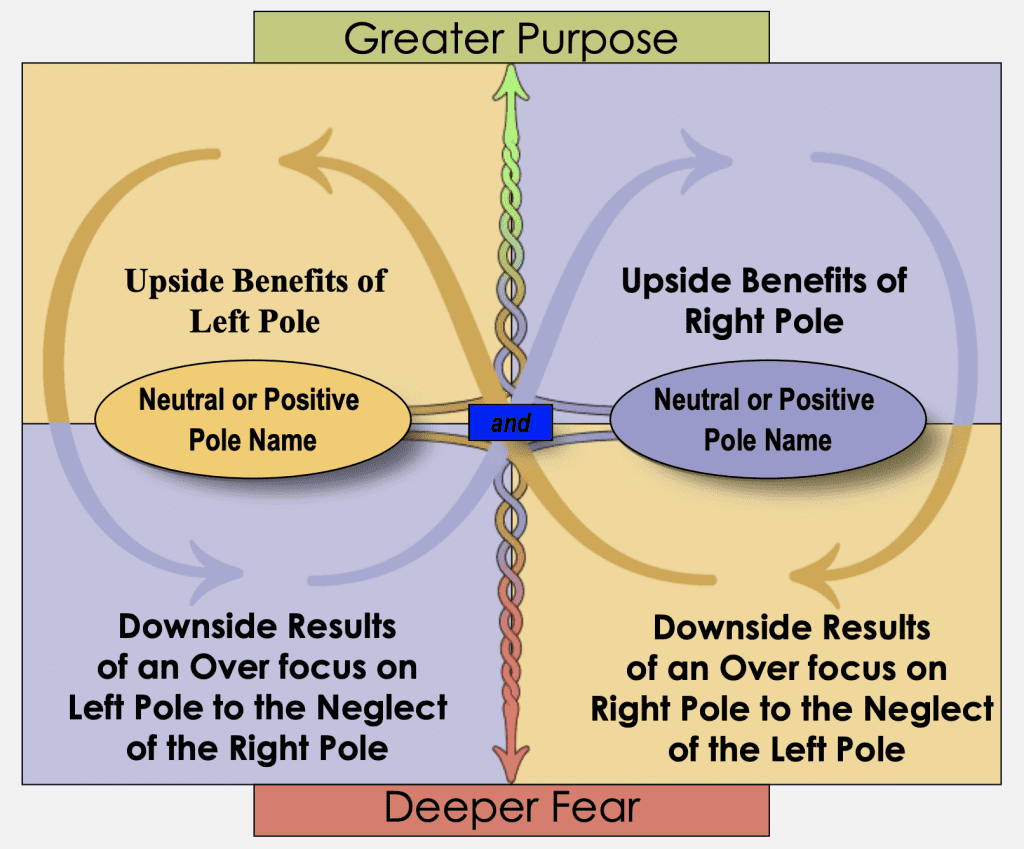
To complete the template, there are also “action steps” and “early warnings” sections to complete:
- “Start with action steps for the pole you are moving from. Then the action steps for the pole your change effort is moving to. That’s what is paradoxical about it. If you want to change the bathwater, make sure you’ve got a good hold on the baby—then you can change the bathwater.”
- “We need to make sure we’re doing a good job of holding on to what we think is important (action steps in upper left) then we look at what we’re going to go after as a solution (action steps in upper right). And, how do we do both of those things?“
- “To make sustainable progress, key stakeholders will need to see the underlying polarity and commit to action steps supporting both upsides.”
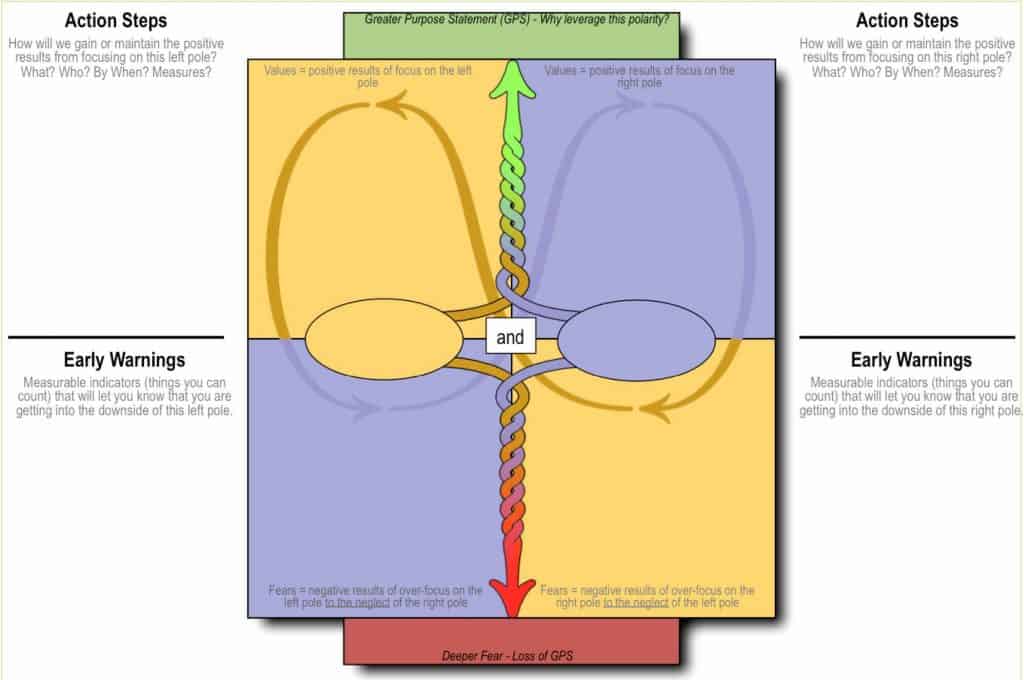
When you put it all together, energy continuously flows back and forth around both poles. In the animated example below, the upsides are maximized and the downsides are minimized. So, there will be a virtuous cycle of energy lifting toward the greater purpose and away from the deeper fear:
- “A well-managed polarity is one in which you capitalize on the inherent tensions between the two poles. You get the benefits of both upsides and the synergies between them. The results are that you fulfill more and more of your higher purpose.”
Running a Marathon (Polarity Map Example):
Let’s pick up our activity and rest polarity (but now in the Polarity Map template):
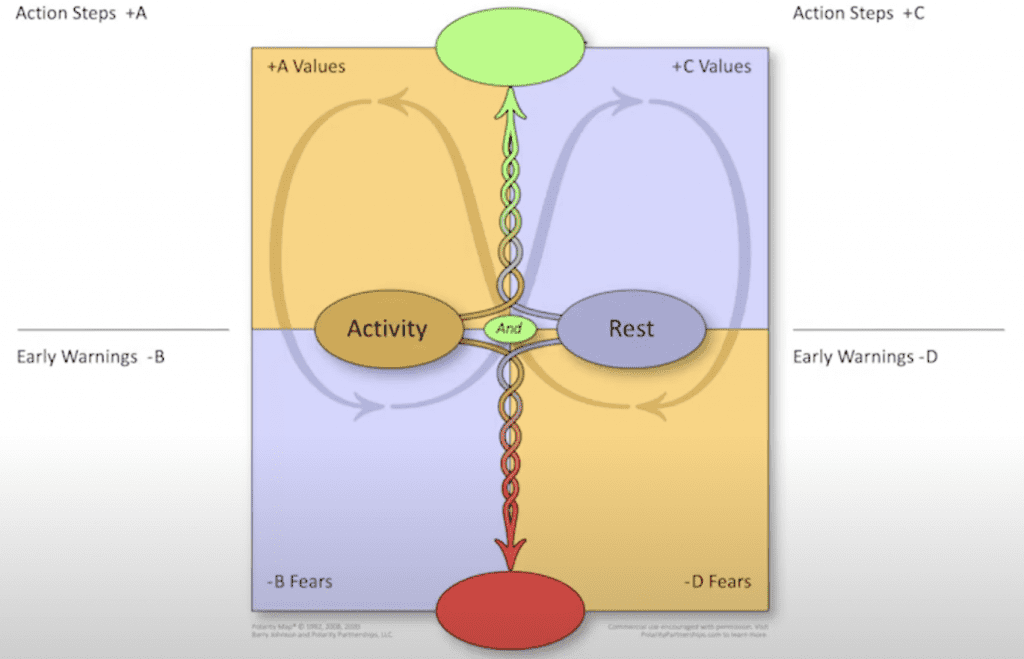
Let’s say our greater purpose is to “run a marathon” and our deeper fear is “can’t run a marathon.” This allows us to fill in all the blanks (values, fears, action steps, and early warnings):
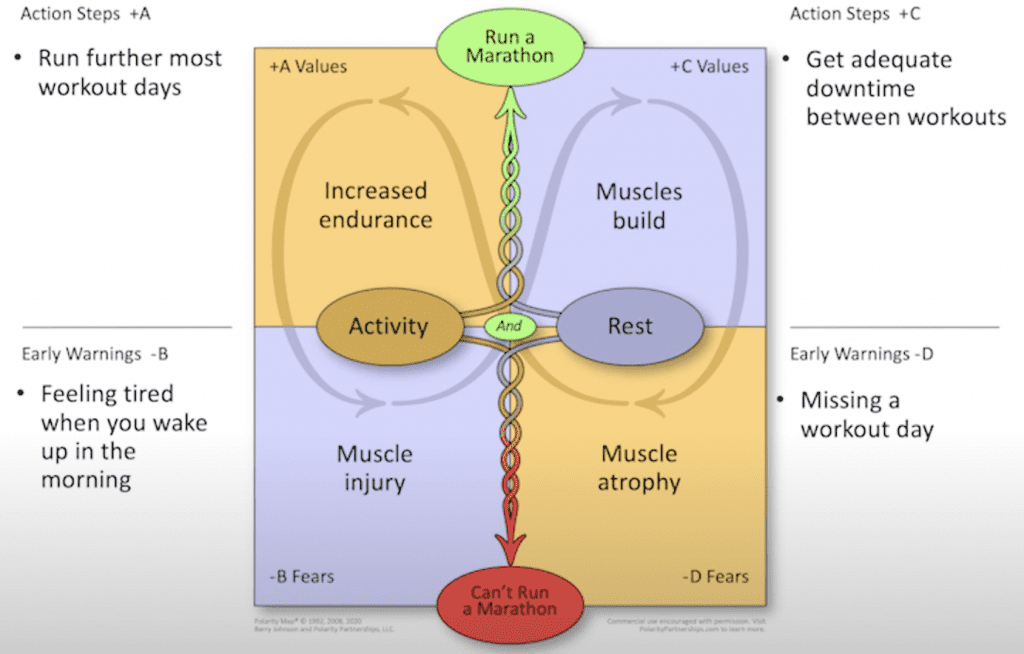
Now, let’s see what can go wrong. What happens if you focus too much on activity at the expense of rest? You get the downside of injury:
- “If you over-focus on one pole or the other—to neglect of its partner—first you get the downside of the pole on which you over-focus—then you get the downside of the other pole as well.”
- “What keeps us from moving from one pole to another is our fear of the downside of the pole we’re moving towards. And the fear is that we’re going to lose the upside of the pole we’re moving from.”
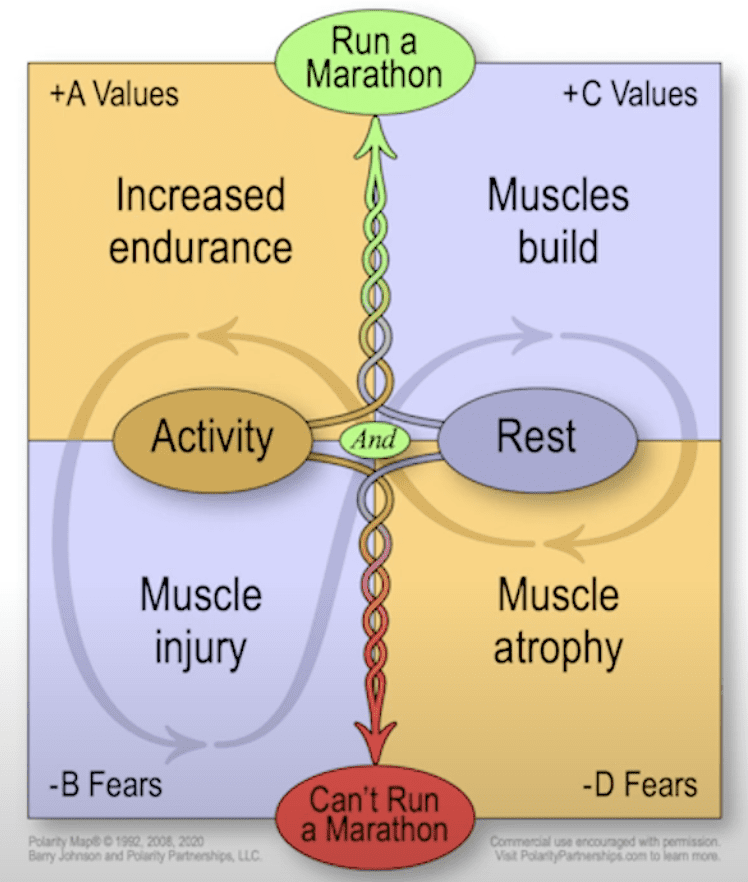
Now, because you are injured, you’re going to have to rest more. So, your muscles are going to atrophy:
- “If a change you’re trying to make is essentially a move from the downside of one pole of a polarity as the ‘problem’ to the upside of its interdependent pole as the ‘solution,’ you will generate unnecessary resistance, and the results of the struggle will be unsustainable.”
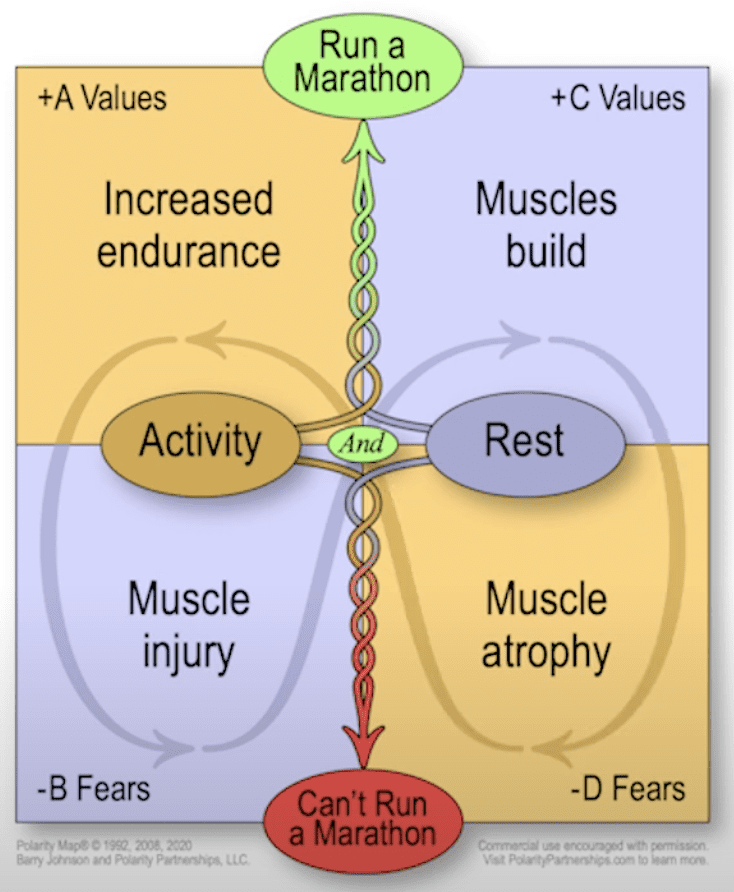
Is it a Problem or a Polarity?
“A fundamental question to ask when encountering a difficulty is: ‘Is this a problem we can solve, or is it an ongoing polarity we must manage well?’“
Problems to solve have:
- One right answer: “If I’m right, my opposition is wrong.”
- Two or more right answers that are independent: “There’s more than one alternative here, let me try this or that one.”
Polarities to leverage have:
- Two right answers that are interdependent: “I and my opposition are not only both right, we are each dependent on the other’s truth over time.”
The four questions that help us determine whether an issue is a polarity or a problem:
For each question: Yes = Probably a polarity to leverage; No = Probably a problem to solve.
- Is the issue ongoing, like breathing?
- Is there an interdependence between two alternatives such that if we choose one alternative for the moment, we will be required to include the other alternative at some point in the future?
- Is it necessary over time to have both identified upsides?
- Will focusing on one upside to the neglect of the other eventually undermine efforts to move toward your greater purpose?
Here’s a short summary guide:
- “Every day we waste energy and create pain from misdiagnosing a paradox and treating it as a problem to solve and then fighting over the two poles.”
- “Polarities are ongoing, chronic issues that are unavoidable and unsolvable. Attempting to address them with traditional problem solving skills only makes things worse.”
- “Polarities always contain problems to solve. Problems to solve can be a part of a polarity, and they can have polarities within them.”
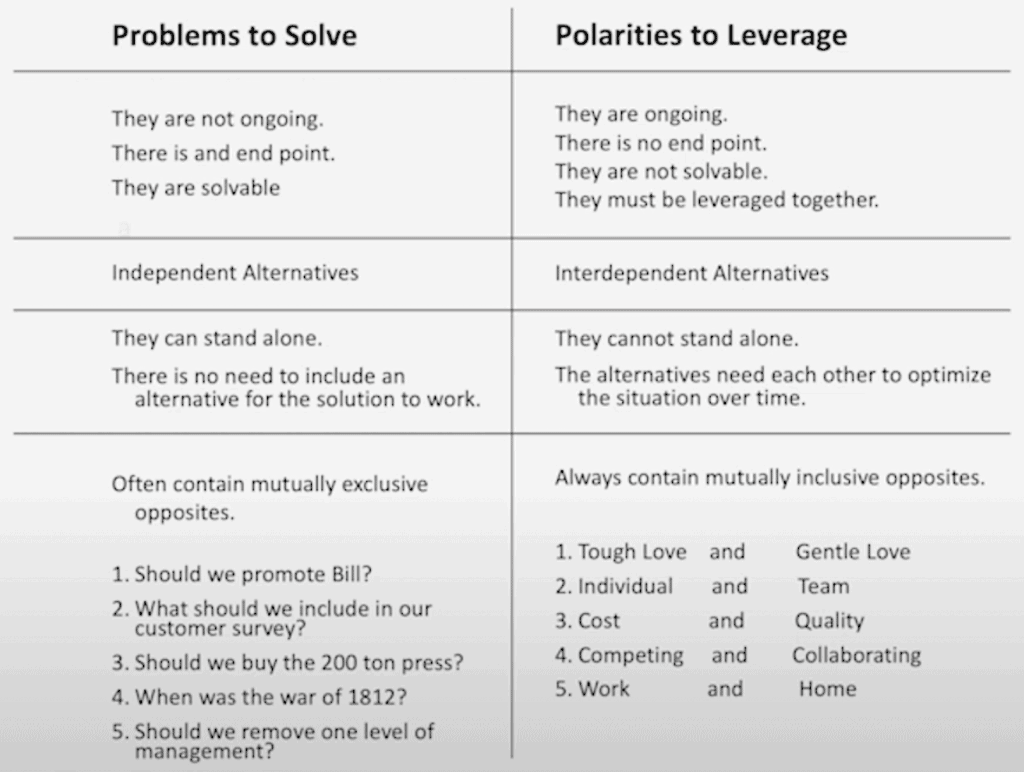
That’s it for now! Stay tuned for a Polarity Thinking 201 post in the future.
If you want to go deeper in the meantime, I recommend reading this paper about how polarity thinking relates to Ego Development Theory from Susanne Cook-Greuter and Beena Sharma.
You May Also Enjoy:
- What is Spiritual Intelligence? The Twenty-One Skills of “SQ21” by Cindy Wigglesworth (Book Summary)
Sources:
- youtu.be/M4qMUhUNAbE
- youtu.be/T_IFw7HI5P8
- vimeo.com/user46500560
- polaritypartnerships.com
- researchgate.net/publication/269489666_Reflections_A_Perspective_on_Paradox_and_Its_Application_to_Modern_Management




